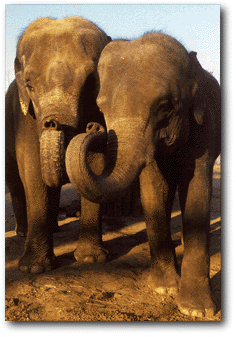ASIAN ELEPHANT
(INDIAN ELEPHANT)
Elephas maximus
MAMMAL
Order Proboscidea
Description
Smaller of the two species of elephant. 18-21 ft long, 7-8 ft high at shoulder, weight up to 12,000 lbs; males larger. Color gray, but varies with soil color since elephants wallow and throw dirt on themselves. Skin sparsely covered with coarse hair. Head with two dome-shaped bulges, back rises in the middle, small ears, trunk with one "finger". Tusks do not develop beyond the lips in females. Five front toes, four hind toes.
Range
India, Sri-Lanka, Indochina, Malaysia, Indonesia and southern China.
 Status
Status
This species is listed as endangered and trade of this species is prohibited by international law. Population decline is due to habitat destruction and poaching for ivory. Lincoln Park Zoo is a member of the Asian elephant Species Survival Plan group.

 Ecology
Ecology
- Habitat
- thick forest and grassy plains.
- Niche
- herbivorous: eats mainly grasses and leaves; woody parts of trees and shrubs, flowers, fruits and roots are also eaten. Principal food is bamboo. Adults need about 330 lbs of food and about 22 gal water each day, and will travel long distances to feed every day. Young preyed upon by lions, hyenas or tigers. Herds follow the same paths over several generations resulting in wide cuts through the bush. Bull and cow herds live apart; matriarch herds have a complex social behavior.
Life History
Reproductive cycle corresponds to seasonal food and water supplies. Bulls enter an aggressive condition called "musth" during rutting season. Gestation 22 mo. Birth wt. about 220 lbs. Infant suckles with mouth 3-4 years. Maturity at 10+ yrs. Life span in the wild 15-30 yrs, in captivity 60-80 yrs. Asian elephants have been kept in captivity for over 5000 yrs, used as beasts of burden and as ceremonial animals.
Special Adaptations
- Upper lip and nose elongated and muscularized to form a trunk which is used for feeding, pulling up vegetation, throwing dust, squirting water, as a snorkel, for vocalizations, and as an organ of touch, smell and communication.
- Prehensile "finger" at end of trunk can pick up very small objects.
- Tusks can be used to force bark off trees, dig for roots, or as weapons.
- Large surface area of foot spreads great weight of animal over a wide
area; thick padded soles absorb shock and cushion legs.
